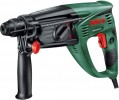Add to comparison |  |  |
|---|---|---|
| Bosch PBH 2900 RE 0603393106 | Bosch PBH 2800 RE 0603393020 | |
from $128.32 up to $143.96 | from $139.96 up to $186.64 | |
| User reviews | ||
| TOP sellers | ||
Model 0603393122 is supplied without a case and keyless chuck, model 0603393106 is supplied with a case but no keyless chuck, and model 0603393100 is supplied with a case and keyless chuck | ||
| Operating modes | hammer drilling drilling only chiselling (demolition hammer) | hammer drilling drilling only chiselling (demolition hammer) |
Specs | ||
| Power consumption | 730 W | 720 W |
| Impact energy | 2.7 J | 2.6 J |
| Number of thrusts | 4000 bpm | 4000 bpm |
| Rotation speed | 1450 rpm | 1450 rpm |
| Rated load speed | 1100 rpm | 1100 rpm |
| Reverse | slider | slider |
| Motor location | horizontal | horizontal |
Chuck | ||
| Chuck type | SDS+ | SDS+ |
| Wood drilling max. ⌀ | 30 mm | 30 mm |
| Metal drilling max. ⌀ | 13 mm | 13 mm |
| Concrete drilling max. ⌀ | 26 mm | 26 mm |
| Max. hole saw ⌀ | 68 mm | 68 mm |
Features | ||
| Functions | speed controller safety clutch power button lock | speed controller safety clutch power button lock |
General | ||
| Power source | mains (230 V) | mains (230 V) |
| In box | additional handle depth gauge case (bag) | additional handle depth gauge case (bag) |
| Weight | 3 kg | 3 kg |
| Added to E-Catalog | may 2015 | june 2012 |